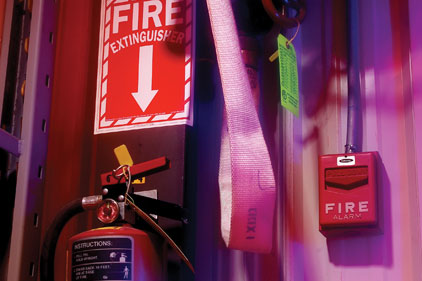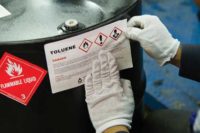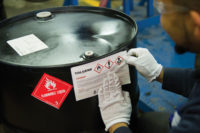These statistics serve as a reminder that fire is a real possibility for any employer. Chemicals, production processes, manufactured goods, waste and packaging can all create fire hazards. Recent studies indicate that up to 85 percent of workplace fires are due to human error and behavior. Developing a fire prevention plan is the best defense.
OSHA requirements
Some OSHA standards specifically address such fire-related issues as emergency exits, fire suppression systems, and handling of combustible wastes and flammable liquids. Of course you are expected to be in compliance with them. But two standards in particular can assist with planning for emergencies.
Generally, if you have fire extinguishers in your workplace, or if you use or store ethylene oxide, methylenedianiline and 1,3 butadiene, OSHA requires you to have a fire prevention plan under 29 CFR 1910.39.
And if you fall under any of the OSHA standards below, you are required to have an emergency action plan under 29 CFR 1910.38:
- Process Safety Management of Highly Hazardous Chemicals, 1910.119
- Fixed Extinguishing Systems, General, 1910.160
- Fire Detection Systems, 1910.164
- Grain Handling, 1910.272
- Ethylene Oxide, 1910.1047
- Methylenedianiline, 1910.1050
- 1,3 Butadiene, 1910.1051
Even if you don’t fall under the requirements of either standard, both 1910.38 and 1910.39 provide excellent guidance to help create a written fire prevention plan, which will make your workplace safer.
Fire prevention plan
An effective fire prevention plan should:
- Be available for employee review.
- Address common housekeeping issues to control combustibles.
- Include procedures for storage and cleanup of flammable materials.
- Address handling and packaging of flammable waste.
- Control workplace ignition sources such as smoking, welding and burning.
- Provide for proper cleaning and maintenance of heat-producing equipment such as burners, heat exchangers, boilers, ovens, stoves and fryers and require storage of flammables away from this equipment.
- Inform workers of the potential fire hazards of their jobs and plan procedures.
- Provide for an employee alarm system throughout the workplace that includes voice communication or sound signals such as bells, whistles or horns.
- Describe exit routes for workers to use and procedures to follow during evacuation.
- Account for all evacuated employees.
- Include employee training.
Housekeeping
Good housekeeping rules are intended to prevent the buildup of combustibles to prevent fires. And OSHA requires that “all places of employment, passageways, storerooms, and service rooms shall be kept clean and orderly and in a sanitary condition.” An effective housekeeping program should:
- Keep work areas free of dust, lint, sawdust, scraps, packaging and similar material.
- Minimize the storage of combustible materials.
- Make sure that doors, hallways, stairs and other exit routes are kept free of obstructions.
- Provide for disposal of combustible waste in covered, airtight, metal containers.
- Require that boxes and paper are stored away from potential ignition sources.
- Include separating incompatible, potentially chemically reactive substances away from each other.
- Clean up flammable liquid leaks immediately.
- Make frequent inspections to prevent fires before they start.
Flammable materials
The recent Hazard Communication Standard update includes changes to some of the definitions found in
the Flammable Liquids standard. However, employers must still:
- Store Category 1 or 2 flammable liquids, or Category 3 flammable liquids with a flashpoint below 100 °F (37.8 °C), in closed, approved containers.
- Use only approved pumps, taking suction from the top, to dispense liquids from tanks, drums, barrels or similar containers or use approved self-closing valves or faucets.
- Only dispense Category 1 or 2 flammable liquids, or Category 3 flammable liquids with a flashpoint below 100 °F (37.8 °C), when the nozzle and container are electrically interconnected.
- Store, handle and use flammable liquids only in approved locations where vapors are prevented from reaching ignition sources such as heating or electric equipment, open flames, or mechanical or electric sparks.
When not in use, all flammable liquid containers should be properly stored in a flammable storage cabinet, inside storage room or flammable storage warehouse.
Flammable waste
Handle flammable waste products properly. Flammable waste products, or shop towels used to clean up them up, must be collected and stored in such a way as not to create a hazard. This typically means a metal container with a tight-fitting lid.
Store soiled towels in closed containers that are clearly marked “soiled shop towels only.” And, do not pour liquids onto used towels; this may create a fire or explosion hazard.
Ignition sources
There can be any number of ignition sources in the workplace, including:
- Smoking areas;
- Heating, ventilating and air conditioning systems, including their pipes, switches, wiring and boiler controls;
- Electrical equipment, including wiring and controls and extension cords;
- Static electricity; and
- Hot work.
Workplace rules and work practices will address employee behaviors, and proper maintenance will help with equipment issues
Maintenance
Equipment may be installed to control heat sources or to detect fuel leaks. There may be temperature limit switches for dip tanks and ovens, or flame failure and flashback arresters on furnaces. These devices must be properly maintained so that they remain operative.
Fires can result from poor ground connections, frayed wiring or overloaded fuses, circuits, motors or outlets. Exhaust and ventilation systems serving heating systems or heat sources must also be properly maintained.
OSHA regulations require the proper maintenance of spraying areas and exhaust systems associated with painting and coating operations to prevent the buildup of combustible wastes.
The fire prevention plan should include periodic inspection or testing, following manufacturer’s recommendations for maintenance procedures.
Employee training
Educate your employees about the types of emergencies that may occur and train them in the proper course of action. Be sure all your employees understand the:
- Company written fire prevention plan;
- Individual roles and responsibilities;
- Threats, hazards and protective actions;
- Notification, warning and communications procedures;
- Emergency response procedures;
- Evacuation, shelter and accountability procedures;
- Location and use of common emergency equipment; and
- Emergency shutdown procedures.
Once you have reviewed your emergency action plan with your employees and everyone has had the proper training, it is a good idea to hold practice drills as often as necessary to keep employees prepared.
If evacuation wardens are used, they must be trained on all evacuation procedures, workplace layout, alternative evacuation routes, hazardous areas and their role in accounting for employees.
Employee alarm systems
Alarm systems signal the need for evacuation, and fire detection systems summon firefighters in the event of a fire. Consider the following for your alarm system:
- Distinctive alarms which can be recognized by all employees as a signal to evacuate;
- A public address system, portable radio unit, or other means to notify employees of the emergency and to contact local law enforcement, the fire department and others; and
- Alarms that can be heard, seen or otherwise perceived by everyone in the workplace, with an auxiliary power supply in the event that electricity is shut off.
Emergency exits
Clearly marked, safe and accessible evacuation routes, as addressed by 29 CFR 1910.36, are essential to ensure that workers and other occupants can escape quickly in the event of fire. This will also be covered under your local code.
Fire doors must not be blocked or locked when employees are inside. Exit routes from buildings must be free of obstructions and properly marked with exit signs.
Assembly areas
Designate evacuation assembly locations and establish headcount procedures. Poor or confusing head count procedures can lead to delays in rescuing anyone trapped in the building, or unnecessary and dangerous search-and-rescue operations. Once you have identified safe assembly locations and head count procedures, consider these options:
- Determine how to identify the names and last known locations of anyone not accounted for and pass them to the official in charge;
- Establish a method for accounting for non-employees such as suppliers and customers; and
- Establish procedures for further evacuation in case the incident expands. This may consist of sending employees home by normal means or providing them with transportation to an offsite location.
Be prepared
Even if you are not specifically required to do so, developing a fire prevention plan and training your employees is a good way to protect yourself, your employees and your business during an emergency. Your insurance carrier and your local emergency responders can provide assistance and guidance for developing fire and emergency plans.


